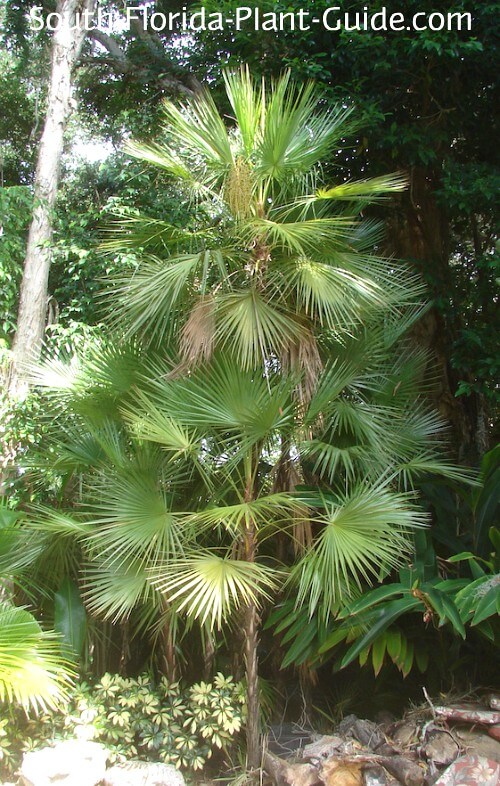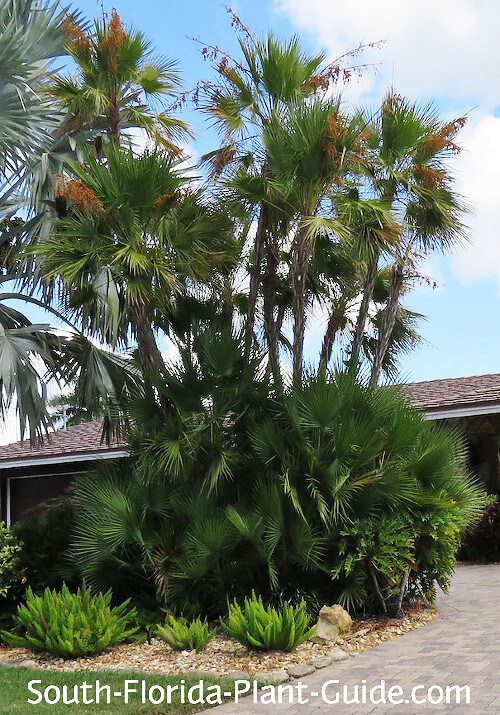Paurotis Palm
Acoelorrhaphe wrightii
The clustering paurotis palm forms a tropical oasis of slim trunks, fan leaves and a casual, "naturalized" Florida look.

The paurotis is often called "Everglades Palm" because it's a native that grows there in dense stands.
The tall, slender trunks retain leaf bases (called "boots") and fiber, for a soft crusted look that complements the bright green fan-shaped leaves.
If this palm thins out - with fan leaves clustered only at the top - the look can be skimpy.
Leave some suckers (young shoots) to fill in with leaves in at different heights.
When kept well-trimmed, this is one palm that can look spectacular with nightime uplighting.
Plant specs
The paurotis is an easy-care palm, cold hardy throughout South Florida including Zone 9B.
It grows slowly in sun to part shade, and can eventually reach a height of 25 feet.
This moderately salt-tolerant palm spreads to form a large cluster, so plant in a spot where eventual spreading will be restricted (edged by sidewalk, patio, house).
These are deer-resistant palms, though nothing is really deer-proof.

This palm has white flowers in spring, which then produce fruit. The photo above was taken in early fall, when the clusters of fruit turn orange. When they fully ripen to black, the berries attract birds.
Plant care
No soil amendments are necessary for this palm.
Even though these are native palms for South Florida, fertilization is necessary for the paurotis's health and good looks.
Apply a good-quality granular palm fertilizer with micronutrients 3 times a year (spring, summer and autumn).
Trim off browned fronds for a cleaner look. You can cut off emerging shoots at ground level to keep the palm's width in check, but leave some for a prettier, more ornamental look.
You'd think a palm that grows wild in the Everglades could handle poorly drained soil and swampy conditions. Not the paurotis. In spite of what many sources may tell you, it needs well-drained soil, and though it's moderately drought-tolerant, it prefers a regular watering.
Plant spacing
Because this is a clustering palm with some height, you'll want to situate it 4 feet (or more) from the house to keep it away from eaves and roof lines. Along a fence, however, it can be planted as close as 3 feet out.
If you're using paurotis palms for screening or to grow in a row, plant 3 or more feet apart.
The paurotis is not a good choice for a container palm.
Landscape uses for paurotis palm
- as a "hedge" along the property line
- accenting the corner of the house
- to add interest along a blank wall
- stand-alone specimen for the yard
- tall, tropical backdrop for other plants
- as a privacy screen for pool or patio areas
- architectural accent plant near the entry
A.K.A. (also known as): Everglades Palm
GOOD SNOWBIRD PLANT? YES
COMPANION PLANT SUGGESTIONS: Plumbago, gold mound, snowbush, ligustrum sinensis, fountain grass, or other plants that form "clouds" around the palm's base.
Other palms you might like: Chinese Fan Palm, European Fan Palm
Take a break!
The ultimate guide to low-maintenance plants
and landscaping!
An ebook by
Chase Landre
author of
South-Florida-Plant-Guide.com
Learn more!
Get a greener thumb!
Want to learn more about South Florida planting, watering, fertilizing and dealing with weeds and pests?
See our Gardening How-To section for answers!
Get instant curb appeal!
An ebook by
Chase Landre
author of
South-Florida-Plant-Guide.com
Learn how to get instant curb appeal with fast growing plants and landscaping techniques!



